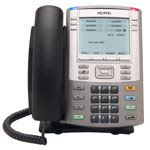[ad name=”ad-articlebodysq”]I’d like to take some time to discuss Voice over IP and share some of my real world experiences with the technology. I should note to everyone that my experiences with VoIP are strictly limited to Nortel equipment. While I’m somewhat knowledgeable about Cisco Callmanager (mostly thanks to my cousin who maintains the Call Center for a large automotive manufacturer) my personal experiences are limited to Nortel.
We’ve been using VoIP for almost the past 6 years with very good success. Our first forey into VoIP was using Nortel’s IP Line ITG (Internet Telephony Gateway) with a Nortel Meridian 1 Option 61C switch. We had Nortel’s first generation i2004 phones (the purple “barney” phones as we fondly referred to them). A few hardware and software upgrades later that same system is now known as Nortel’s Succession 4.5 1000M Call Server. We’ve been running IP Trunks (H.323) between 5 different Succession 4.5 1000M Call Servers for well over 4 years now with great success. We’ve only just in the past year started really rolling out VoIP to the desktop where it makes sense (example; new construction).
What do you need to run VoIP with Nortel?
These days you can run VoIP on all sorts of different platforms from small office (BCM 50) to very large multi-site enterprises (CS 2100). I’ll describe the equipment that I’m currently using;
- Nortel Succession 4.5 Call Server 1000M
- Nortel Succession 4.5 Signaling Server (two for high availability)
- Nortel Succession Voice Gateway Media Cards (five for high availability and capacity)
- Nortel Succession Internet License (Incremental Software Management – ISM)
You’ll need a phone of course;
- Nortel i2002 Internet Telephone
- Nortel i2004 Internet Telephone
- Nortel 1140E Internet Telephone
- Nortel i2050 Software internet Telephone
You’ll also need some back-end network electronics/switches;
- Nortel Ethernet Routing Switch 8600 (core)
- Nortel Ethernet Routing Switch 5520 PoE (edge)
And to make life easy you’ll also need a DHCP server which you can configure with custom vendor DHCP options.
If your a data person you’re most likely going to need some help from either a voice/telecom person or voice reseller. Likewise if your a voice/telecom person you’re going to need some help from either a data person or a data reseller. I happen to be a data person that has learned the voice/telecom side of things from my years of exposure and from the failure of several voice resellers, nothing like picking up the books and learning something new.
Since I’m a data person I’m going to focus on the actual network electronics and the phone configuration. In the past year I’ve deployed more than 250 IP phones at more than 5 locations. That number doesn’t include the 100 or so Nortel 2211 Wireless Internet Telephones which we’ll discuss at some later date.

I currently have a Nortel 1140E (pictured right) on my desk at work along with a Nortel i2007 on my desk at home (Nortel 1150 VPN Router with Branch Office Tunnel – BOT) and an i2050 software IP phone on my laptop with a USB headset adapter that really makes the phone work.
We recently built a health center with 140+ IP phones which are all connecting to a hospital that is more than 17 miles away. We built a 10GB Wide Area Network over dark fiber utilizing Nortel Ethernet Routing Switch 8600s with 8683XLR cards and 10GBase-ER/EW XFP GBICs. We also installed and provisioned a Nortel 1000B Branch Office at the health center to provide a failover solution should the IP phones get disconnected from the Main Office Call Server. This site has been live for the past 5 months now and I’m very satisfied with the result of our work and efforts. The solution is very reliable and thanks to the design of the data network we’ve yet to experience an unscheduled outage.
Stay tuned for more…